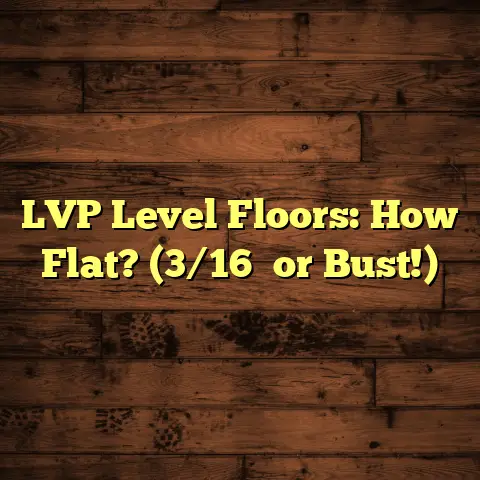Chair Mat On Hardwood Needed? (4 Costly Mistakes!)
And let me tell you, one of the biggest headaches I see time and time again?
Damage from office chairs!
Are you battling scratches and dents from your rolling chair?
Thinking about slapping down a chair mat?
Hold up!
It’s not as simple as it seems.
Choosing the wrong chair mat, or neglecting its upkeep, can actually worsen the problem. Trust me, I’ve seen it happen.
Today, I’m going to share 4 costly mistakes I’ve witnessed homeowners make with chair mats on hardwood.
Avoid these, and you’ll save yourself a ton of money and heartache down the road.
Ready? Let’s dive in!
The Importance of Hardwood Floor Protection
Let’s face it, hardwood floors are beautiful.
They add warmth, character, and value to your home. According to the National Association of Realtors, hardwood floors can increase a home’s resale value by as much as 2.5%.
But they’re also an investment.
And like any investment, you need to protect it. Think of it like this: you wouldn’t drive your brand-new car without insurance, right?
Hardwood floors face a daily barrage of threats:
-
Foot traffic: Shoes track in dirt, grit, and small rocks that act like sandpaper on the finish.
-
Pet claws: Our furry friends can leave scratches, especially if they love to run and play indoors.
-
Dropped objects: We’ve all been there – a phone, a book, a heavy vase – and bam! – a dent in the floor.
-
Furniture legs: Even stationary furniture can cause wear and tear over time, especially if it’s frequently moved.
But one of the biggest culprits?
Chair movement.
That’s where chair mats come in.
The right chair mat acts as a shield, absorbing the impact of chair wheels and preventing scratches, dents, and other damage.
But, as I mentioned earlier, not all chair mats are created equal.
Let’s explore those costly mistakes!
Mistake #1: Underestimating the Impact
of Chair Movement
Okay, I get it.
It might seem like a little rolling chair can’t do that much damage.
But trust me, it adds up.
Think about how often you move your chair throughout the day.
Rolling back to reach for something, swiveling to talk to a colleague, scooting closer to your computer screen.
Each of those movements puts pressure on your hardwood floor.
And over time, that pressure translates into visible wear and tear.
Here’s why chair wheels are so damaging:
-
Concentrated weight: All your weight is focused on those tiny wheels, creating a high-pressure point.
-
Abrasive action: Chair wheels can trap dirt and debris, turning them into miniature grinding wheels that scratch the finish.
-
Constant repetition: The same areas of the floor are subjected to repeated wear, leading to localized damage.
I’ve seen floors where you can literally see the path of the chair wheels etched into the finish.
It’s not pretty.
In fact, a study by the American Society for Testing and Materials (ASTM) found that repeated rolling of a chair over a surface can cause significant abrasion and wear, especially on softer materials like hardwood.
Real-Life Horror Story:
I once had a client who dismissed the idea of a chair mat.
“It’s just a little chair,” he said. “It’s not going to hurt anything.”
Fast forward two years, and his once-pristine hardwood floor was riddled with scratches and dents.
The cost to refinish the floor?
Over \$3,000!
He learned his lesson the hard way.
Don’t make the same mistake!
Mistake #2: Choosing the Wrong Type of
Chair Mat
So, you’re convinced you need a chair mat.
Great!
But don’t just grab the first one you see.
The type of chair mat you choose is crucial for protecting your hardwood floors.
Here’s a rundown of common chair mat materials and their suitability for hardwood:
-
PVC (Vinyl): This is the most common and affordable type of chair mat. However, I strongly advise against using PVC mats on hardwood floors. They can leach chemicals that discolor the finish, and they tend to crack and curl over time, creating a tripping hazard.
-
Polycarbonate: A much better option than PVC. Polycarbonate mats are more durable, resistant to cracking, and won’t leach chemicals. They’re also clear, so they won’t detract from the beauty of your hardwood floor.
-
Tempered Glass: This is the most durable, but also the most expensive option. Tempered glass mats are virtually indestructible and won’t crack, warp, or discolor. They’re also very easy to clean. However, they can be slippery, so make sure to choose one with a non-slip backing.
-
Natural Materials (Bamboo, Cork): These are eco-friendly options that can look great on hardwood floors. However, they may not be as durable as polycarbonate or tempered glass, and they may require more maintenance.
Important Note: Some hardwood flooring manufacturers specifically state in their warranties that using PVC chair mats will void the warranty.
Why?
Because PVC mats can damage the floor!
Common Misconceptions:
-
“All chair mats are the same.” Nope! Material matters.
-
“A thicker mat is always better.” Not necessarily. The type of material is more important than the thickness.
-
“I can use any chair mat, as long as I put a rug underneath it.” This might offer some protection, but it’s not a substitute for choosing the right type of chair mat.
My Recommendation:
For most situations, I recommend a polycarbonate chair mat.
It offers a good balance of durability, affordability, and aesthetics.
If you’re willing to spend a bit more, a tempered glass mat is an excellent choice.
Mistake #3: Neglecting the Size and Shape
of the Chair Mat
Okay, you’ve chosen the right material.
Excellent!
But don’t stop there.
The size and shape of your chair mat are just as important.
A chair mat that’s too small won’t provide adequate protection, while one that’s too large can be a tripping hazard.
Here’s what to consider when choosing the size and shape:
-
Workspace dimensions: Measure the area where you typically move your chair. You want the mat to extend beyond the reach of your chair wheels in all directions.
-
Chair type: If you have a large executive chair, you’ll need a larger mat than if you have a smaller task chair.
-
Desk configuration: If your desk is L-shaped or U-shaped, you may need a custom-shaped mat to provide adequate coverage.
Visual Aid:
Imagine a circle around your desk. The diameter of that circle should be the minimum size of your chair mat.
Consequences of Improper Sizing:
-
Increased wear on unprotected areas: If the mat is too small, your chair wheels will inevitably roll onto the hardwood floor, causing scratches and dents.
-
Tripping hazards: An oversized mat can create a tripping hazard, especially if it extends into walkways.
-
Discomfort: If you constantly have to adjust your chair to stay on the mat, it can be uncomfortable and distracting.
Pro Tip:
When in doubt, err on the side of a larger mat.
You can always trim it down to size if necessary.
Just make sure to use a sharp utility knife and a straight edge for a clean cut.
Mistake #4: Failing to Maintain the Chair
Mat Properly
You’ve chosen the right material, the right size, and the right shape.
You’re all set, right?
Not quite!
Even the best chair mat won’t protect your hardwood floor if you don’t maintain it properly.
Think of your chair mat as a dirt and debris magnet.
Every time you roll your chair across it, you’re grinding dirt, dust, and small particles into the surface.
Over time, this buildup can actually scratch your hardwood floor!
Here’s why regular maintenance is essential:
-
Prevents dirt and debris buildup: Regular cleaning removes abrasive particles that can scratch the floor.
-
Extends the life of the mat: Proper care prevents cracking, warping, and discoloration.
-
Maintains a clean and healthy workspace: A clean chair mat contributes to a more hygienic environment.
Cleaning Tips:
-
Vacuum regularly: Use a vacuum cleaner with a brush attachment to remove loose dirt and debris.
-
Wipe down with a damp cloth: Use a damp cloth and mild detergent to clean the surface of the mat. Avoid using harsh chemicals or abrasive cleaners.
-
Deep clean periodically: Once or twice a year, give your chair mat a thorough cleaning with a specialized chair mat cleaner.
Frequency:
I recommend vacuuming your chair mat at least once a week and wiping it down with a damp cloth as needed.
Don’t Forget the Underside!
Periodically lift the chair mat and clean the underside.
This will prevent dirt and debris from accumulating between the mat and the hardwood floor.
Bonus Tip:
Consider using a rug pad underneath your chair mat.
This will provide an extra layer of protection and prevent the mat from slipping.
Conclusion
So, there you have it!
Four costly mistakes to avoid when using a chair mat on hardwood floors.
Let’s recap:
-
Don’t underestimate the impact of chair movement. It’s more damaging than you think.
-
Choose the right type of chair mat. Avoid PVC and opt for polycarbonate or tempered glass.
-
Select the proper size and shape. Ensure adequate coverage and avoid tripping hazards.
-
Maintain the chair mat properly. Regular cleaning is essential.
By following these tips, you can protect your hardwood floors and avoid costly repairs down the road.
Remember, a little preventative maintenance goes a long way!
Do you have any questions about chair mats or hardwood floor protection?
Leave a comment below, and I’ll do my best to answer them.
Happy flooring!





